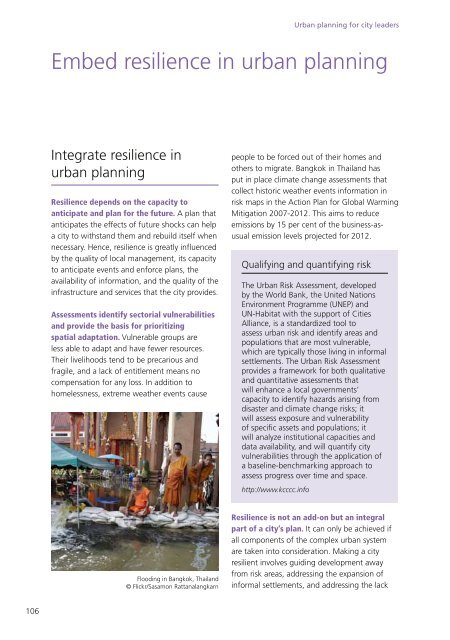Urban Planning for City Leaders - Cities Alliance
Urban Planning for City Leaders - Cities Alliance
Urban Planning for City Leaders - Cities Alliance
You also want an ePaper? Increase the reach of your titles
YUMPU automatically turns print PDFs into web optimized ePapers that Google loves.
<strong>Urban</strong> planning <strong>for</strong> city leadersEmbed resilience in urban planningIntegrate resilience inurban planningResilience depends on the capacity toanticipate and plan <strong>for</strong> the future. A plan thatanticipates the effects of future shocks can helpa city to withstand them and rebuild itself whennecessary. Hence, resilience is greatly influencedby the quality of local management, its capacityto anticipate events and en<strong>for</strong>ce plans, theavailability of in<strong>for</strong>mation, and the quality of theinfrastructure and services that the city provides.Assessments identify sectorial vulnerabilitiesand provide the basis <strong>for</strong> prioritizingspatial adaptation. Vulnerable groups areless able to adapt and have fewer resources.Their livelihoods tend to be precarious andfragile, and a lack of entitlement means nocompensation <strong>for</strong> any loss. In addition tohomelessness, extreme weather events causepeople to be <strong>for</strong>ced out of their homes andothers to migrate. Bangkok in Thailand hasput in place climate change assessments thatcollect historic weather events in<strong>for</strong>mation inrisk maps in the Action Plan <strong>for</strong> Global WarmingMitigation 2007-2012. This aims to reduceemissions by 15 per cent of the business-asusualemission levels projected <strong>for</strong> 2012.Qualifying and quantifying riskThe <strong>Urban</strong> Risk Assessment, developedby the World Bank, the United NationsEnvironment Programme (UNEP) andUN-Habitat with the support of <strong>Cities</strong><strong>Alliance</strong>, is a standardized tool toassess urban risk and identify areas andpopulations that are most vulnerable,which are typically those living in in<strong>for</strong>malsettlements. The <strong>Urban</strong> Risk Assessmentprovides a framework <strong>for</strong> both qualitativeand quantitative assessments thatwill enhance a local governments’capacity to identify hazards arising fromdisaster and climate change risks; itwill assess exposure and vulnerabilityof specific assets and populations; itwill analyze institutional capacities anddata availability, and will quantify cityvulnerabilities through the application ofa baseline-benchmarking approach toassess progress over time and space.http://www.kcccc.infoFlooding in Bangkok, Thailand© Flickr/Sasamon RattanalangkarnResilience is not an add-on but an integralpart of a city’s plan. It can only be achieved ifall components of the complex urban systemare taken into consideration. Making a cityresilient involves guiding development awayfrom risk areas, addressing the expansion ofin<strong>for</strong>mal settlements, and addressing the lack106
















